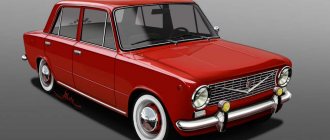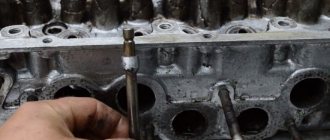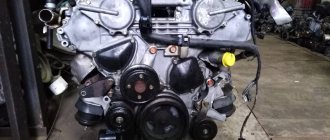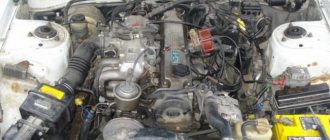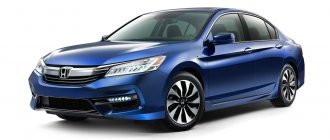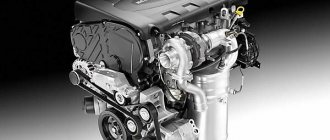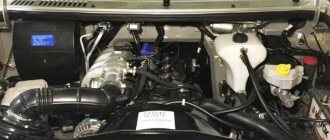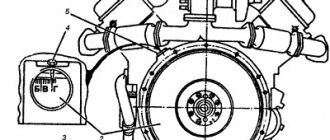Top 5 most reliable Mercedes.
The number of Mercedes models is so large that it can be difficult to keep track of them.
As for reliability, at first glance it is difficult to get an answer. Not because the cars are of poor quality, but simply because over the many years that they have been on the market, some cars have been on the list of the best. So, the top 5 most reliable Mercedes. •Mercedes w210. This car was first released in 1995 and immediately made a good impression. As for engines, there are a huge number of them, namely more than 20. Starting from a 2.0 liter diesel engine with a power of 95 horses and ending with a 5.5 liter V8 engine with a power of 354 hp. The motors are quite reliable and all of them use a timing chain. Some owners claim that engines can last up to 1 million km. The gearboxes, both manual and automatic, also show excellent performance.
•Mercedes w212. This car even now looks quite modern and attractive. The most reliable of the entire line of engines can be considered a 3.0-liter turbo diesel. Problems with injectors and turbocharger begin after 350 thousand km, but the engine itself does not need to be repaired until 500 thousand km. The suspension is multi-link, both front and rear. In general, the car is comfortable and reliable.
•Mercedes w201. By the way, this is the first Mercedes to have a rear independent 5-link suspension installed, and it undoubtedly added comfort and stability when cornering. The engines here are very durable and with proper maintenance they will cover 600 thousand km. It is better to take a manual gearbox, because... The automatic will leak oil. This car was made with soul and is designed to last for more than one decade.
•Mercedes G-class. This frame SUV is equipped with permanent all-wheel drive, reduction gearing and locking of all 3 differentials. The all-wheel drive here is quite reliable, and even if the owner of the Gelika comes for repairs, it is most likely due to the driveshaft cross. The engines are quite reliable, but require a professional approach and, due to Russian fuel, often fail to withstand spark plugs.
•Mercedes w124. This is one of those Merc models thanks to which the company has gained credibility. Everything that can be seen in this car was certainly made to last for many years, so that later there would be no shame. Although engines can cause some inconvenience, because... Still, the car is quite old, but all the parts can be found either at disassembly sites or in stores with good quality replicas. The car has already passed more than a decade and is still driving and driving, so there should be no debate about its reliability.
Like and subscribe to our channel.
Source
The most reliable gasoline engine
Considering that the most unreliable engines have already been discarded, we need to look at the top engines running on gasoline.
Toyota 3S-FE. First in the rating due to its reliability and ease of maintenance. However, the “recipe” for its success is quite transparent: a working volume of 2 liters, sixteen valves installed, a timing belt on a belt and distributor injection. If we talk about power, it ranged from 130 to 140 hp. depending on the version.
It is also worth noting that it is one of the company's most successful products, and its production duration dates from 1980 to 2000. They were equipped with such models as: Celica T200, Avensis, RAV4, etc. Durability and reliability are justified by user reviews who had no problems up to 600 thousand km. mileage
Mitsubishi 4G63. The engine has a volume of 2 liters, which is distinguished by the presence of three valves per cylinder, as well as one camshaft. Subsequently, the second version, starting in 1987, received two camshafts (the original version was produced since 1980). Over time, the original version acquired several varieties, where the gas distribution system, fuel supply, etc. were changed. There are also turbocharged versions.
As such, popularity and reliability is confirmed by the fact that in 2021 most gasoline engines are produced by Chinese manufacturers (Kia, Hyundai, etc.) under a purchased license.
Honda D-series. The most flexible versions due to the fact that for 2021 there are several types with a volume range from 1.2 to 1.7 liters and power up to 130 hp. The series was released from 1984 to 2005. D15 and D16 were recognized as the most reliable.
Models of this series have engines: Civic, Accord, HR-V, etc. Drivers note the absence of problems up to 500 thousand km. mileage
Which engine is the most reliable? Obviously 4G63. However, all this is synthetic, numbers. First of all, it is necessary to rely on those characteristics that will be directly involved when using the car. The durability of the motors listed here is approximately the same.
TOP 5 BEST and WORST MERCEDES MOTORS
If we were talking about the end of the 20th century, then about the power units produced by the Mercedes-Benz division of Daimler-Benz AG, one could unequivocally say that, without being at the forefront of technological progress, they were the most reliable and indestructible engines, superior therefore the parameter of all its competitors. But the 21st century dictates its own laws and, introducing its generally accepted technical innovations and “bells and whistles” (compliance with environmental standards, reduced fuel consumption, the introduction of the latest control and safety systems), Mercedes-Benz engines have lost their positions in this matter to many other automakers.
TOP 5 best engines from Mercedes-Benz
M 271
The winner of our rating is a gasoline engine from the popular and “famous” series of “one hundred and eleventh engines” - M 271 (in-line, piston, four-cylinder six-valve) 1.8 liter, which was produced for 8 years in the “zero years” of the 21st century only in Stuttgart (Germany) ). Its predecessor was generally “iron” in every sense, which cannot be said about the subsequent M 272/M 273 series, which, not without reason, were among the three worst engines of the Mercedes-Benz brand.
The M 271 engines were equipped with aluminum blocks with cast iron liners, variable valve timing, a double camshaft, and a double ventilation system. The KE and DE modifications with a head height of 11.5 cm have one cylinder block. The engine is equipped with a special anti-vibration mechanism with a built-in oil pump. An undoubted success was the continuously variable valve timing control on each camshaft.
With an average gasoline consumption of about 7 liters per 100 km, the service life of this “indestructible” engine is a third of a million kilometers. As a drawback, the owners noted the increased noise level inside the car, which was still less than that of the previous engine, and could be eliminated quite easily with the installation of crankcase protection.
Professionals noted a common drawback for all Mercs - stretching of the timing chain (hereinafter referred to as the timing chain), although in this particular case the engine itself did not need to be removed when replacing it, which of course gives the M 271 a “huge” plus. However, the M 271 also had its own “zest” - the internal oil filter gasket, which was located behind the “arrow” pillar, and it was already a part of the body.
OM 611
The second place is confidently occupied by the diesel engine OM 611 (200–220 SDI) with 4 cylinders and 16 valves, with 2 overhead camshafts, a volume of 2.15 liters, which was produced for 4 years at the end of the last century and 6 years at the beginning of this year. At first its power was 82-125 l/s, and since 1999 it reached a maximum of 143 l/s at 105 kW. Installed: a “Common rail” injection system, an intercooler and a turbocharger, and an oxidation catalyst for cleaning exhaust gases.
CANNY
The current E 200 is equipped not with a 2-liter engine (the index no longer corresponds to the working volume in cubic centimeters with zero discarded), but with a 1.8-liter supercharged engine. Before major repairs, it can easily travel 400,000 km - unless, of course, adventures happen to it, which we will tell you about below. One of the weak points is the timing mechanism. On pre-restyling models produced before 2013, cases of chain stretching and malfunction of the variable phase system clutch on the intake shaft are common. The locking mechanism of the advance mechanism in the clutch is destroyed, and the engine makes a diesel roar.
TOP 5 “worst” engines from Mercedes-Benz
M 272
The first place in this rating is occupied by the gasoline engine, all made of aluminum with a thin alusil coating, the M 272, V-type, six-cylinder, 24-valve, 2.5 and 3.5 liters. Atmospheric engines of the M 272 family, produced in Stuttgart, have always been quite problematic. Their main “disease” is scuffing on the cylinders and pistons. They clearly appeared as soon as the car covered 100 thousand km and required replacing the entire shot block, which is quite expensive.
The reason is the ingress of particles of the precipitating neutralizer into them. And the timing chain had to be changed twice during this time. Owners of cars with this engine were bothered by constant oil leaks, as well as malfunctions in the thermal operating mode, especially in the spring and autumn, because dirt and any debris builds a so-called “felt boot” between the engine cooling radiators and the air conditioner.
To the company for a vehicle recall to replace balancer shafts, which was carried out in 2008-2009. tried to eliminate all or most of the above disadvantages of this engine. But Mercedes-Benz was sure that in 2004 it released an excellent engine and installed it in almost all of its cars. Merc specialists fought desperately for this engine and gradually it became better and more reliable, but... the “sediment” remained.
OM 651
The second place is confidently taken by the OM 651 diesel engine, 4-cylinder with 16 valves, V-shaped, 204 l/s, with injection and turbocharger, as well as a constantly decreasing displacement (from 2.5 l to 1.8 l since 2011), since this is a modern trend - increasing power while reducing engine capacity. Engines with a power of more than 170 l/s were turbocharged, and less with a turbocharger. In addition to the ill-fated timing chain, this engine suffered from serious problems with injectors and coolant leaks.
Mercedes-Benz in 2011-2012 (OM 651 was produced since 2008) even went to replace cars equipped with this engine under warranty. A drop in power was constantly caused by wear and, accordingly, destruction of the valves, and if they were not replaced in a timely manner (and replacement is not the cheapest, since the entire manifold needs to be replaced), then a breakdown could occur. And the separation of the damper that was not replaced in time severely damaged the engine.
V-engines produced since 2004
From third to fifth place are occupied by V-shaped engines, produced since 2004. This distribution is made on the basis of reviews from mechanics and service station workers, who consider “sixes” to be much more reliable than “fours” and, especially “eights” (since they are shorter than their counterparts V-8 per cylinder, and in 2013, the “specialists” from Mercedes-Benz eliminated all violations of their temperature regime, which made them much more viable). These engines upset their owners immediately and “in a big way”, since they love oil and do not last long:
- The timing drive actually “survives” until it reaches its hundred thousandth mileage, but is replaced with the dismantling of the engine itself.
- The hydraulic tensioner may need to be replaced much earlier.
- The alusil coating of engine blocks is very sensitive to everything and lasts half as long as superchargers. Seizures on them appear due to leaking injectors and “sintering” of the lubricant.
- Huge oil consumption, reaching up to one liter per thousand kilometers, is due to this “waste”.
- A significant number of used seals leak not because of the quality of their material, but because of the increased temperature, by about ¼, reaching up to 125 degrees Celsius.
Which Mercedes engine is the most reliable?
Reviews and features of Mercedes engines: diesel and gasoline engines, top best power plants, their characteristics. Video about Mercedes-AMG engines.
Among drivers from different countries, there is a popular legend about an engine that never fails. And to confirm this, data is provided on “million-dollar” units with mileage from 500 thousand to 1 million km. Most of these installations are presented in the model range of the German automaker Mercedes.
What to be afraid of in the secondary market when choosing a Mercedes
A pre-restyling Mercedes-Benz E-class in the 212th body costs an average of 900 thousand rubles, after restyling - 1.3 million rubles. The prices are considerable, so it’s better to play it safe and check the history of the piece you like.
For 1.6 million rubles I found a 2014 Mercedes with a mileage of 60 thousand km:
The avtocod.ru report shows that the mileage is not much, but twisted (the penultimate recorded mileage is 60,113 km).
There is also an accident involving a collision with an obstacle. Before him, judging by the calculations of the repair work, the car was hit twice. In the first case, the hood and front left fender were replaced, in the second - the rear right fender and the rear right passenger door. The list of work according to the latest calculation includes the replacement of the front and rear bumpers. Apparently the car is completely broken.
Plus, it is subject to traffic police restrictions - there will be problems with registration. That is, it is better to look for another car.
Also read: Living luxuriously is not forbidden: the most expensive cars on the secondary market
A little about the company
The Mercedes-Benz brand has managed to gain a reputation as one of the highest quality and most popular car manufacturers in the world. It is one of the three “titans of Germany” and regularly expands its line with interesting new products. During its existence, the company has developed more than a dozen engines with various modifications and technical characteristics.
Individual editions are distinguished by incredible durability and build quality. Advanced technologies and components are used for their production. The most reliable engines from Mercedes-Benz embody the best achievements of engineering in the field of engine manufacturing.
The best diesel installations
In terms of reliability, diesel engines are superior to their gasoline counterparts. And if a few decades ago it was difficult to imagine a sports car with such a unit, today the concept looks completely different. Current models of diesel engines are designed for high-speed driving and extreme operating conditions. At the same time, they have a simple structure and improved strength properties.
Mercedes-Benz OM602
The line of OM602 diesel engines from Mercedes-Benz is in great demand among car enthusiasts. It includes 5-cylinder units with 2 valves per cylinder and a mechanical injection pump manufactured by Bosh. The series confidently holds a leading position in the ranking of the most durable and reliable engines, adapted for heavy loads.
The model was produced from 1985 to 2002, and over an almost 20-year period of time it managed to win the trust of hundreds of customers from all over the world. The power reserve varies from 90 to 130 hp. s., because the main priority was placed on efficiency and reliability. The predecessors of the family were the OM617 releases, and the successors were the OM612 and OM647.
The average mileage is 500 thousand km without serious breakdowns. Record levels reach 1.5-2 million kilometers. And if you properly maintain the main components, as well as replace consumable parts, the unit will never let you down.
Mercedes 2.2 CDI (OM611/OM646)
Mercedes 2.2 CDI (OM611/OM646) is another durable unit from the German automaker with a different number of cylinders (4, 5 and 6). The most popular versions are OM611 and OM646 with common rail direct injection. The modifications practically repeat each other, differing only in the configuration of the fuel system and attachments.
In various sources and on thematic forums, engines are designated as 2.1 or 2.2. CDI. The actual volume of installations is slightly less than 2150 cm3.
According to customer reviews, Mercedes 2.2 CDI engines (OM611/OM646) have no negative aspects. The fuel system has a long service life, the turbines work properly, and the 2-row timing chain can be used for 500 thousand kilometers. Some models have swirl flaps that break up the mounting holes in the intake manifold.
OM 617
The OM617 is a popular engine manufactured by Mercedes-Benz, which integrates 5 cylinders and indirect fuel technology from Daimler Benz. The first releases of the unit were presented to the public in 1974 as a replacement for the 4-cylinder OM616 model.
Independent experts and car enthusiasts classify this engine as a “million-dollar” engine, because The mileage of individual issues exceeds 1 million km. Because of this feature, the engine was incredibly popular in the United States in the 1980s.
Initially, a unit with a turbocharger was used on S-class and mid-price segment cars. Daimler-Benz was driven by the desire to maintain the economical fuel consumption prescribed by the US government regulations.
The volume of the OM617 from 1974 is 3005 cc. cm, and the power is 80 l. With. The rotational potential is 172 Nm. The 1982 Turbo OM617A has a displacement of 2998 cc. cm and power 125 l. With. Torque reaches 250 Nm.
OM 651
In 2008, the Mercedes-Benz engine line was replenished with the OM 651 diesel model with 4 cylinders, 16 valves and a Common Rail fuel supply system. The installation can be turbocharged or biturbo.
Initially, the unit has a volume of 2.2 liters, but since 2011 a 1.8-liter version has appeared in the range. The two diesel engines have identical cylinder diameters, but the smaller one has a shortened piston stroke - 84 mm rather than 99 mm. The compression ratio in both editions is 16.2:1.
The power reserve is 204 hp. With.
The engine was used on C-Class 250 CDI cars, having a dual turbocharger and Delphi piezoelectric injectors. This configuration appeared on later modifications and the 170-horsepower version. The OM 651 is used as a replacement for a wide range of older engines.
The best gasoline engines
On the Russian market, gasoline engines are more common than diesel engines. This is due to the fact that the fuel does not freeze during cold periods, and the design of the power unit looks simpler.
M271
The leading place in the ranking is occupied by the M271 4-cylinder petrol engine with a displacement of 1.8 liters. It was produced for 8 years at the beginning of the 21st century. Germany. The previous model was distinguished by maximum reliability and durability, so the manufacturer decided to preserve the old traditions and integrated its best practices into the M271 release.
The engine is equipped with a special vibration absorption mechanism with an integrated oil pump. Average fuel consumption is 7 liters per 100 km, and the operating life reaches 350,000 km.
The disadvantages of the model include increased noise and the problem of timing chain stretching, which is common for all engines of the concern.
M166 E
Next in the ranking was the popular M166 E engine, which was very popular in the late 90s. last century. It was installed on A-class cars.
2-cylinder 1.6-liter unit with a power reserve of 102 hp. With. coped with its tasks perfectly, including transporting cargo weighing from 1 ton (the unit itself weighed just under 100 kg). At the same time, fuel consumption was no more than 10 liters of gasoline per 100 km of driving at speeds of up to 182 km/h.
Russian motorists fell in love with the engine because of its stable operation in all weather and climatic conditions. Even when used in winter, it performed its functions efficiently without preheating or other difficulties.
The working life of the model reaches several hundred thousand kilometers, provided that the owner of the car regularly maintains it, changing the timing belt after 100 thousand kilometers.
M282 DE 20 AL turbo
The next place is reserved for the M 82 DE 20 AL turbocharged petrol engine with two cylinders, 8-valve layout and V-shaped design. The volume of the unit is 1.3 liters, and the power reserve is 360 “horses”. This figure allowed the engine to claim the title of the most powerful 4-cylinder engine produced on an industrial scale.
Initially, the power plant was used on the Mercedes-Benz A 45 AMG. The power reserve on one fill of 56 liters reached 700 km. As a guarantee of quality, the principle of “one man, one engine” was provided, which was applied at the Kellede plant.
The integration of new technologies, such as start-stop, Camtronic, Blue Direct and others, allowed the engine to become one of the five most reliable engines produced by Mercedes-Benz. Among the failures common to many other gasoline engines, the M282 DE 20 AL turbo may experience periodic electronic bugs and noise during startup.
M119 E50
The 5-liter M119 E50 engine is the first engine in the M119 line, which is located between the simplified modification of the E42 and the sport version of the E60 AMG or E63 AMG. The new product integrates an aluminum cylinder block with a 90-degree camber, as well as light-alloy pistons and forged connecting rods.
Other technical characteristics of the model are as follows:
- production – Stuttgart-Bad Cannstatt Plant;
- years of production – from 1989 to 1998;
- food - injection;
- configuration – in-line;
- cylinders - 8 pieces;
- valves per cylinder – 4;
- cylinder diameter – 96.5 mm;
- volume – 4973 cubic meters. cm;
- torque 480 Nm.
During the existence of the line, dozens of its modifications were presented. However, all versions encountered some common problems, namely:
- Engine knock. Extraneous noise appears when there is no oil supply and is generated by hydraulic compensators. To fix the problem, it is enough to change the connectors for supplying the oil mixture;
- Unstable work. Such problems appear when the timing chain is stretched and it is necessary to check its condition.
Additional disadvantages include the impressive size of the engine, which takes up most of the space under the hood and is subject to increased wear due to heat.
M112 E32
The M112 E32 engine was introduced in 1997, when it was introduced as a successor to the legacy E32 edition of the M104 series. The model was distinguished by a V-shaped configuration and a camber angle of 90 degrees.
The use of non-in-line placement of cylinders reduced the size of the power plant for maximum unification of 6- and 8-cylinder exhausts. To reduce the weight of the engine, the developers replaced the cast-iron cylinder block with an aluminum alloy kit. Each sleeve is made of silumin. To reduce inertia, a balancing shaft was installed in the engine block.
Conclusion
The reliability of Mercedes-Benz engines has been proven by the experience of thousands of car owners. However, the company has both the best motors and the worst. Therefore, when choosing the appropriate option, you need to take into account the reviews of other drivers and independent experts. It is also important to weigh all the pros and cons of the model you are interested in, and also look at the manufacturer’s recommendations for servicing the installation. In this case, the engine will operate uninterruptedly for a long period of time.
Video about Mercedes-AMG engines:
Source
About engines for Mercedes-Benz C-Class
Premium models of the Mercedes-Benz C-Class are invariably popular among fans of class D cars, which in 1992 replaced the Mercedes 190E. Under the hood of the best-selling luxury model, a variety of engines were installed: from not very powerful 1.8-liter units to 3.2 and 3.5 liter volume units.
Engine Mercedes-Benz M111 E20 / E20 ML 2.0 l
The history of the next series of 4-cylinder Mercedes-Benz engines began in 1992 with the new M111 E20 engine. The developers re-created a small cast iron BC with a different crankshaft, connecting rods and pistons.
The 16-valve cylinder head with two DOHC camshafts received hydraulic compensators and electronic fuel injection. Along with the aspirated engine, a compressor version of the M111 E20 ML was produced with a supercharger in the form of an Eaton M62 roots compressor.
The timing chain drive resource is 250 thousand kilometers.
Two years later, the series of Mercedes M111 E20 engines was modified and as a result the engines received new connecting rods and pistons corresponding to the increased compression ratio. The BCs with stiffeners became different, the combustion chambers and channels in the head changed, the ignition coils and fuel system were improved, different spark plugs and EDS appeared, and eco-standards reached Euro-4. Engines with the EVO designation received a total of more than one hundred updates.
The disadvantages of the M111 E20 series engines include oil leaks, loss of power and high fuel consumption.
The noisy operation of the engines, the fragility of the spark plugs and pumps were also noted.
After overcoming the milestone of 200 thousand kilometers, the piston skirts may wear out and cracks may appear on the exhaust manifold.
The service life of these engines has basically already been exhausted and other faults may be added to those listed above. 4+
Engine Mercedes-Benz M113 E43 4.3 l
The M113 E43 power unit appeared in 1997 and was intended to replace the M 119 E 42. The modified engine became an 8-cylinder version of the M112E32 with a 90-degree camber and without a balancer shaft. The aluminum cylinder head has one camshaft and three valves per cylinder. The IFGR system, hydraulic compensators and a variable-length intake manifold are still used. The timing chain drive lasts about 200 thousand kilometers. After 2005, the M113 E43 unit was replaced by the M 273 E46 with a volume of 4.7 liters.
Typical disadvantages of the M113 E43 engine include high oil consumption due to wear of the valve stem seals.
It is also inherent in the engine to leak oil due to the sealing of the oil heat exchanger.
After 80 thousand kilometers, the crankshaft pulley damper may delaminate, and if low-quality fuel is used, the injectors quickly fail. 4+
Engine Mercedes-Benz M271 E18 ML/AL 1.8 l
In 2012, the next series of in-line fours was released, which immediately replaced all members of the M111 family. The M271 E18 power units received a completely different aluminum cylinder block with cast iron liners and a 2-shaft balancer. Aluminum cylinder head with two camshafts, hydraulic compensators and an IFGR system. At the same time, the cylinder head had two types of cylinder head with different intake channels, combustion chambers and camshafts for direct distributed injection.
The supercharger is an Eaton M65 compressor, and the timing chain drive lasted only up to 100 thousand kilometers, but later this problem was eliminated.
In 2009, the compressor was replaced with a turbocharger and the cylinder head was modified. Improved M271 E18 engines were produced with the EVO prefix.
The main disadvantages of the M271 E18 include unstable operation of the unit caused by a burst ventilation hose. This engine is also characterized by a loss of performance and tripping at idle.
The first versions of the engine used an unreliable timing chain, and over time it began to make noise when starting.
On the latest versions of the M271 E18 EVO, the oil level sometimes increases because gasoline gets into it. 4
Engine Mercedes-Benz M272 KE/DE 35 3.5 l
The M272 E 35 power unit was an evolution of the Mercedes V6 and was supposed to replace the M112 E32 and M112 E37. In addition to the 3.5-liter engine, the line includes a 2.5-liter M272 E25 and a 3.0-liter M272 E30.
Development of the 272 series was carried out on the basis of the M112, which included an aluminum cylinder head with a camber of 90 degrees and 106 mm between the cylinders. Silumin steel piston liners have a diameter of 92.6 mm. And the new crankshaft received a stroke of 86 mm. The pistons and forged connecting rods have become somewhat lighter. A cylinder head with four valves per cylinder and a pair of DOHC camshafts. For the M272 E 35 engine, a continuously variable IFGR system on two shafts, hydraulic compensators and a two-stage intake manifold with variable length were used.
The resource of the double roller timing chain is approximately 150 thousand kilometers.
Problems with the M272 E 35 include diesel, Check Engine light, and errors 1200 and 1208. Most often this occurs due to wear on the balancer shaft sprockets.
Also inherent in this engine is oil leakage, which requires the replacement of plastic cylinder head plugs.
Engine vibrations indicate the need to change the intake manifold flaps. 4+
| Engines | Mercedes-Benz M111 E20 / E20 ML 2.0 l | Mercedes-Benz M113 E43 4.3 l | Mercedes-Benz M271 E18 ML/AL 1.8 l | Mercedes-Benz M272 KE/DE 35 3.5 l |
| Production | Stuttgart-Untertürkheim Plant | Stuttgart-Bad Cannstatt Plant AMG Plant Affalterbach | Stuttgart-Untertürkheim Plant | Stuttgart-Bad Cannstatt Plant |
| Engine make | M111 | M113 | M271 | M272 |
| Years of manufacture | 1992-2004 | 1997-2005 | 2002-present | 2004-2013 |
| Cylinder block material | cast iron | aluminum | aluminum | aluminum |
| Supply system | injector | injector | injector | injector |
| Type | in-line | V-shaped | in-line | V-shaped |
| Number of cylinders | 4 | 8 | 4 | 6 |
| Valves per cylinder | 4 | 3 | 4 | 4 |
| Piston stroke, mm | 78.7 | 84 | 85 | 86 |
| Cylinder diameter, mm | 89.9 | 89,9 | 82 | 92,9 |
| Compression ratio | 8.5 (Kompressor) 9.6 10.6 (see modifications) | 10 | 9-10,5 | 10.7 12.2 11.7 |
| Engine capacity, cc | 1998 | 4266 | 1796 | 3498 |
| Engine power, hp/rpm | 136-129/5100-5500 163-192/5300-5400 (Kompressor) | 272/5750 279/5750 306/5850 | 122-192/5200-5800 | 258/6000 272/6000 292/6400 305/6500 316/6500 |
| Torque, Nm/rpm | 185-190/3500-4000 230-250/2500 (Kompressor) | 390/3000 400/3000 410/3250 | 190-260/1500-3500 | 340/2500 350/2400 365/3000 360/4900 |
| Fuel | 95 | 95 | 95 | 95 |
| Environmental standards | Euro 3 Euro 4 (since 2000) | Euro 4 | Euro 5 | Euro 6 |
| Engine weight, kg | — | — | ~167 | — |
| Fuel consumption, l/100 km (for C230 Kompressor W203) - city - highway - mixed. | 13.9 6.9 9.7 | 17.7 9.2 12.3 | 9.5 5.5 6.9 | 13.8 7.3 9.7 |
